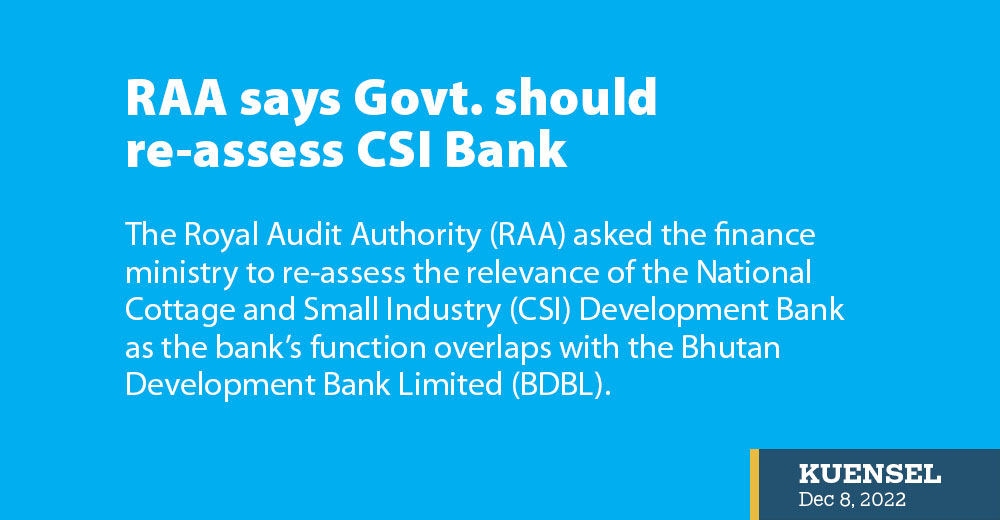…finds the bank and the BDBL overlapping their functions
Thukten Zangpo
The Royal Audit Authority (RAA) asked the finance ministry to re-assess the relevance of the National Cottage and Small Industry (CSI) Development Bank as the bank’s function overlaps with the Bhutan Development Bank Limited (BDBL).
Auditor General Tashi said that the ministry was asked to initiate appropriate intervention to address it to curtail the avoidable and unwarranted cost centres.
In its annual report 2021, the RAA stated that the National CSI Bank had incurred consecutive losses since its inception and depended heavily on the government’s equity injection. “The bank was not even able to cover the operating cost,” the authority said.
The bank incurred a total loss of Nu 43.7 million (M) in 2021 and Nu 64.31M in 2020, according to the bank’s annual report in 2021.
The RAA report also found that the bank’s financial self-sufficiency ratio, return on assets, return on equity, and cash flows were financially not viable for its operation.
“Most of the loan products are similar to what is offered by the BDBL, besides the loan disbursement and equated monthly installment (EMI) collections are also routed through the BDBL,” it added.
This did not add any value to the loan life cycle but instead increased the administrative cost. “The bank has effectively been a cost centre” the report stated.
As of 2021, the bank saw non-performing loans (NPL) of Nu 335.71M which constituted 15.2 percent of the total loans. The NPLs decreased to 11 percent in March this year and 9 percent in June.
Since May this year, the bank had temporarily suspended the loans as directed by the Royal Monetary Authority after observing the bank’s NPLs above the central bank’s threshold of 5 percent. The highest NPLs were recorded in the agriculture sector.
Inadequacies in loan appraisals and follow-up contributed to the NPLs, the report stated. The NPLs are loan repayments that are overdue by 91 days.
In an earlier interview, an official said that the NPLs were alarming at 58 percent under the revolving fund (RF-I) and 18 percent under the revolving fund (RF-II) when the bank took over from the then Rural Enterprise Development Corporation Limited (REDCL). This means, more than half of the loans availed from REDCL have defaulted.
At the start of the 11th five-year plan, the government injected Nu 5 billion (B) as an Economic Stimulus Plan from foreign aid.
Of the total, Nu 2.1B was allocated as subordinate debt to the banks and the government still receives interest from the banks.
While the remaining, Nu 1.9B was allocated to the then Business Opportunity and Information Centre (BOiC) with the introduction of the RF-I and RF-II.
Because of the legality issues, the then BOiC was discontinued and the government started REDCL with Nu 400M under RF-II to carry out micro-lending activities for non-formal economic activities in the rural areas.
Meanwhile, Nu 1.5B under RF-I was injected into the BDBL to finance cottage and small industries through a special window.
Since the bank’s inception in 2020, loans amounting to Nu 2.24B have been disbursed to 6,525 clients.
The highest loans were for the livestock sector worth Nu 832.71M, followed by the agriculture sector with 667.88M and Nu 415.28M in manufacturing and production.


